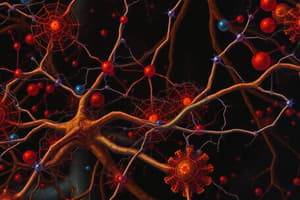Podcast
Questions and Answers
Which type of nerve fiber is responsible for saltatory conduction?
Which type of nerve fiber is responsible for saltatory conduction?
- Aγ (Type III)
- Aβ (Type II)
- Aδ
- Aα (Type I) (correct)
Which type of nerve fiber has the lowest threshold for excitability among the types mentioned?
Which type of nerve fiber has the lowest threshold for excitability among the types mentioned?
- Aγ (Type III)
- Aα (Type I) (correct)
- Aβ (Type II)
- Aδ
Which property of nerve fibers states that they either transmit all of an impulse or none at all?
Which property of nerve fibers states that they either transmit all of an impulse or none at all?
- Conductivity
- Summation
- All or None Response (correct)
- Refraction
Which type of nerve fiber cannot generate a new electrical impulse while conducting one?
Which type of nerve fiber cannot generate a new electrical impulse while conducting one?
Which type of nerve fiber is associated with responding to changes in its surrounding stimuli?
Which type of nerve fiber is associated with responding to changes in its surrounding stimuli?
Which property of nerve fibers signifies that they do not tire even when continuously stimulated?
Which property of nerve fibers signifies that they do not tire even when continuously stimulated?
Which type of nerve fiber is classified as Type II?
Which type of nerve fiber is classified as Type II?
What property of nerve fibers allows electrical impulses to be propagated along their entire length?
What property of nerve fibers allows electrical impulses to be propagated along their entire length?
If a sub-threshold stimulus is applied to a nerve fiber, what happens according to the text?
If a sub-threshold stimulus is applied to a nerve fiber, what happens according to the text?
In the context of nerve fibers, what does 'Summation' refer to?
In the context of nerve fibers, what does 'Summation' refer to?
Flashcards are hidden until you start studying
Study Notes
Neurotrophins
- Small proteins crucial for maintaining nerve cell viability and function.
- Secreted by various tissues like muscles, neurons, and astrocytes.
- Essential for the growth and development of nerve cells in both the central nervous system (CNS) and peripheral nervous system (PNS).
- Functions include promoting nerve cell survival, repair, and overall maintenance of nerve tissue, as well as facilitating neural transmission.
- Recent research shows neurotrophins can induce regrowth in damaged neurons.
- Potential applications in treating neurological disorders such as Parkinson's and Alzheimer's diseases.
Nerve Fibers
- Also known as axons, carry nerve impulses away from the cell body.
- Can be classified based on structure (myelinated vs. non-myelinated), distribution (somatic vs. autonomic), origin (cranial vs. spinal), function (sensory vs. motor), type of neurotransmitter (adrenergic vs. cholinergic), and diameter (Erlanger-Gasser classification).
- Myelinated fibers are faster and more efficient compared to non-myelinated fibers.
- Classification includes three major groups: Type A (thickest, myelinated), Type B (intermediate), Type C (thinnest, unmyelinated).
Neuron Classification
- Two main types of neurons based on length of axons:
- Golgi Type I Neuron: Long axons, more than 100 dendrites, includes motor cells of the spinal cord and pyramidal cells of the cerebral cortex.
- Golgi Type II Neuron: Short axons, more than 30 dendrites, primarily found in the cerebral and cerebellar cortex.
Neuron Structure
- Composed of three main parts: cell body (soma), dendrites, and axon.
- Neuron characteristics include excitability, conductivity, secretion, longevity, and a high metabolic rate.
- Neurofibrils consist of microtubules and microfilaments, providing structural support within neurons.
- Mitochondria serve as powerhouses for ATP production in soma and axons while the Golgi apparatus processes and packages proteins.
Dendrites
- Branching extensions that transmit impulses towards the cell body, generating local potentials.
- May have dendritic spines, facilitating synaptic connections.
- Contain Nissl granules and neurofibrils and are part of the input zone of neurons.
Axon Structure
- Each neuron has a single axon arising from the axon hillock.
- Responsible for carrying impulses away from the cell body; lacks protein-synthesis machinery.
- Can be myelinated or unmyelinated and contains synaptic vesicles for neurotransmitter release.
- The myelin sheath, formed by Schwann cells outside the CNS and oligodendrocytes inside, increases impulse conduction speed.
Myelinated vs. Unmyelinated Nerve Fibers
-
Myelinated Nerve Fibers:
- Presence of myelin sheath accelerates nerve impulse transmission through saltatory conduction at nodes of Ranvier.
- Axons are insulated, leading to more energy-efficient conduction.
- Typically found in both central and peripheral nervous systems.
-
Unmyelinated Nerve Fibers:
- Lack a myelin sheath, resulting in slower impulse transmission through continuous conduction.
- Commonly located in the peripheral nervous system and involve visceral functions.
Saltatory vs. Continuous Conduction
- Saltatory conduction occurs in myelinated neurons, where impulses leap from node to node, enhancing speed and efficiency.
- Continuous conduction occurs in unmyelinated fibers, with impulses propagating along the entire length of the axon at a slower rate.
Key Differences between Myelinated and Unmyelinated Neurons
- Myelinated neurons have a present myelin sheath, faster transmission, and larger axon diameter.
- Unmyelinated neurons lack insulation, transmit impulses slower, and have a smaller diameter.
Studying That Suits You
Use AI to generate personalized quizzes and flashcards to suit your learning preferences.



